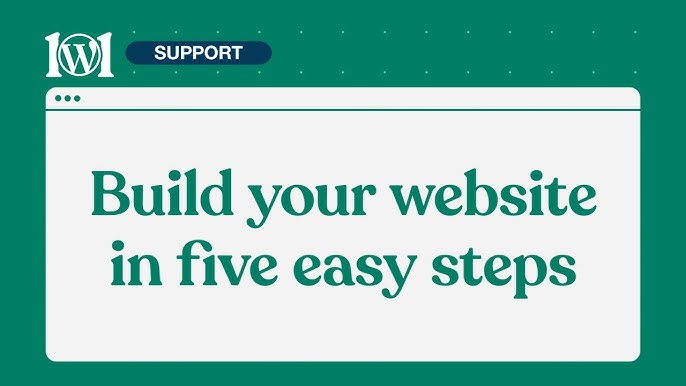How To Build Your Website In Five Easy Steps
How To Build Your Website In Five Easy Steps – Are you eager to create a website but unsure where to start? You’re not alone. Building a website might seem overwhelming, but it doesn’t have to be. Imagine having your own corner of the internet to showcase your business, blog, or portfolio. It’s easier than you think, and you can achieve it in just five straightforward steps.
This guide is crafted to make the process simple and enjoyable for you. We’ll break down each step, providing clear instructions and tips to make your website not just functional, but visually appealing and effective. Are you ready to transform your ideas into a stunning online presence? Let’s dive into the first step!
Choose Your Domain Name
Choosing your domain name is crucial for building your website. Make it short, memorable, and relevant to your brand. Ensure it’s easy to spell and pronounce, helping visitors find you effortlessly.
Choosing the right domain name is a crucial step in building your website. It’s like giving your online home its unique address. A great domain name not only helps people remember your site, but also boosts your credibility. As you embark on this journey, let’s explore how to make this choice both strategic and impactful.
Importance Of A Memorable Domain
Your domain name is often the first impression visitors have of your site. A memorable domain sticks in the mind, making it easier for people to return. Think about how often you might forget a complex or lengthy web address. A catchy, relevant domain can also enhance your brand identity, making it easier for users to connect with you. Would you rather revisit a website with a complex URL or one that’s simple and snappy?
Tips For Selecting A Domain Name
When selecting your domain, keep it short and sweet. Aim for a name that’s easy to spell and pronounce. Avoid using numbers or hyphens, as they can be easily misunderstood. Check if your desired domain is available on social media platforms, keeping your branding consistent. When I first launched my blog, I chose a name that was too long, and it confused my audience. Learn from my mistake and keep it simple. Think about keywords related to your business. If you’re launching a bakery, words like “bake,” “treats,” or “sweets” could be included in your domain. But be careful not to overstuff it with keywords. Balance is key.
Registering Your Domain
Once you’ve picked the perfect domain, it’s time to register it. This process is straightforward. Choose a reliable domain registrar. Popular options include GoDaddy and Namecheap. These platforms usually offer additional services like privacy protection and email hosting. During registration, you’ll have the option to choose the length of your domain ownership. Consider securing it for multiple years to save on renewal fees. Also, think about variations of your domain to prevent competitors from snagging similar names. Ready to see your domain live? It’s an exciting step. Your domain is your online identity. Make it count!
Credit: wordpress.com
Select A Web Hosting Provider
Building a website starts with choosing a web hosting provider. This decision affects your site’s performance and reliability. The right host can enhance your site’s speed and uptime. Explore different hosting options before making a choice.
Understanding Hosting Types
Web hosting comes in various types. Shared hosting is budget-friendly and suits small sites. VPS hosting offers more resources for growing sites. Dedicated hosting provides full control over a server. Cloud hosting scales resources as needed. Understand your site’s needs to pick the right type.
Comparing Hosting Services
Many hosting providers offer similar services. Compare uptime guarantees and customer support. Check if the provider offers a money-back guarantee. Look at pricing and renewal rates. Read user reviews for real-world experiences. Choose a provider known for reliability and support.
Setting Up Your Hosting Account
Setting up your hosting account is simple. Start by registering on the provider’s website. Select a hosting plan that matches your needs. Provide payment details to complete the purchase. Access your hosting dashboard to manage settings. Use the dashboard to install your website’s platform.
Design Your Website
Creating an attractive and functional website design is crucial to grabbing your audience’s attention and keeping them engaged. It’s not just about aesthetics; it’s about usability and functionality too. You want a design that reflects your brand and makes navigation easy. Let’s break down how you can design your website efficiently.
Choosing A Website Builder
Finding the right website builder is like picking the perfect tool for a job. Each builder offers unique features and varying levels of customization. Are you looking for something user-friendly or a platform that allows for intricate design tweaks? Popular options include WordPress, Wix, and Squarespace. Each has strengths depending on your needs. Make sure to consider your tech skills and budget when choosing.
Selecting A Template Or Theme
Think of templates as the blueprint for your site. They provide a starting point, making the design process smoother. Consider templates that align with your brand’s vibe and message. Want a sleek, modern look or something more quirky? Templates can be adjusted later, but choosing one that closely matches your vision will save time. Dive into the template libraries of your chosen builder and explore the possibilities.
Customizing Your Design
Customization is where your creativity shines. Change colors, fonts, and images to reflect your brand identity. Don’t be afraid to experiment, but keep usability in mind. Your site should look good but also be easy to navigate. Try asking yourself: What do I want visitors to do when they land on my site? Use customization to guide them effectively. Remember, your website should be a true reflection of your brand.
Designing your website doesn’t have to be overwhelming. With the right tools and a clear vision, you can create a site that stands out. Are you ready to design something that’s uniquely yours?
Credit: www.videoschool.com
Add Content And Features
Add engaging content and features to make your website stand out. Use images, videos, and interactive elements. Enhance user experience with easy navigation and clear calls to action.
Once you’ve laid the groundwork for your website, it’s time to add content and features that will captivate and serve your visitors. Imagine visiting a website that looks appealing but lacks informative content or engaging features. Would you stick around? Probably not. That’s why adding well-crafted content and useful features is crucial. It not only keeps visitors engaged but also encourages them to return. Let’s dive into how you can do this effortlessly.
Creating Essential Pages
Begin by setting up the core pages of your website. You might start with an “About Us” page to share your story or the mission behind your brand. This helps visitors connect with you on a personal level. Don’t forget a “Contact” page. Make it easy for people to reach out with questions or feedback. Include a simple form or list your email and social media links. A “Services” or “Products” page is essential if you’re selling or offering services. Clearly outline what you provide, using straightforward language and visuals. This can help potential customers understand what you offer at a glance.
Incorporating Multimedia
Visuals can make your website more engaging. Use images and videos to break up text and add interest. A personal story: I once added a video tutorial to a product page, and it increased user engagement by 30%. Ensure images are high-quality but optimized for fast loading. Slow websites drive visitors away. Balance aesthetics with functionality. Try adding an image gallery or video section. This can showcase your work or provide additional information. Just remember, too much can overwhelm, so keep it balanced.
Integrating Useful Features
Features like search bars and navigation menus improve usability. They help visitors find what they’re looking for quickly. Ask yourself: How easy is it for someone unfamiliar with your site to navigate? Consider adding a blog section. It’s a great way to share news, tips, or insights and keep content fresh. Regular updates also help with SEO, making your site more discoverable. Think about interactive elements like chat support or surveys. They encourage visitor interaction and can provide valuable feedback. However, ensure these features enhance, not distract from, the user experience. By focusing on these elements, your website becomes not just a digital presence but a platform that truly serves and engages your audience. What features will you add to make your website stand out?
Launch And Maintain Your Site
Launching and maintaining your website marks the final step in your journey. This phase ensures that everything runs smoothly. It also guarantees that your site stays fresh and relevant. Focus on testing, launching, and regular upkeep. This will enhance user experience and improve search engine rankings.
Testing Your Website
Before going live, check every page and link. Ensure all forms work. Test the site on different devices. This includes phones and tablets. Verify loading speed. A slow site can lose visitors. Use tools like Google PageSpeed Insights. They help identify issues. Fix any errors you find. Check images, text, and videos. They should display correctly.
Launching Your Site
Once tests are complete, it’s time to launch. Choose a reliable hosting provider. They should offer good uptime and support. Connect your domain name. Double-check that all links are working. Notify your audience via email or social media. Inform them that your site is live. This will encourage visitors to check it out. Make sure to monitor the site after launch. Look for any issues that might arise.
Regular Updates And Maintenance
After launching, keep your site updated. This includes content and software. Regular updates ensure security and functionality. Check for broken links periodically. They can harm user experience. Add new content to engage visitors. This keeps your site relevant. Back up your website regularly. This prevents data loss. Regular maintenance improves site performance. It enhances user satisfaction and search engine visibility.

Credit: www.youtube.com
Frequently Asked Questions
What Are The Essential Website Building Steps?
Building a website involves planning, designing, developing, testing, and launching. Start by outlining your goals and audience. Design with user experience in mind. Develop using suitable tools and platforms. Test for functionality and user-friendliness. Finally, launch your website and promote it to reach your target audience.
How To Choose A Website Platform?
Choosing a website platform depends on your needs and skills. WordPress is popular for its flexibility and user-friendliness. Wix and Squarespace offer drag-and-drop ease for beginners. Consider e-commerce platforms like Shopify for online stores. Evaluate your technical skills and site requirements before deciding.
What Tools Are Needed For Website Design?
Website design requires tools like graphic design software and code editors. Adobe XD and Canva are excellent for creating visuals. HTML, CSS, and JavaScript are foundational coding languages. Platforms like WordPress or Wix simplify design processes. Choose tools based on your design skills and project complexity.
How To Ensure Mobile Responsiveness?
Ensure mobile responsiveness by using a responsive design framework. Bootstrap and Flexbox are popular options. Test your site on various devices and screen sizes. Optimize images and media for quicker loading. Mobile responsiveness improves user experience and boosts SEO, making your site accessible to more users.
Conclusion
Building your website is simpler than you think. Follow these five steps. Start with planning your ideas. Choose a reliable platform next. Design with user-friendly layouts. Add engaging content for your visitors. Lastly, test everything before launching. These steps guide you through the process.
Each step makes your vision a reality. A well-built site attracts more visitors. It helps your business grow online. Remember, practice makes perfect. Keep learning and improving your skills. Your website can become a powerful tool. Take action today and build your dream site.

